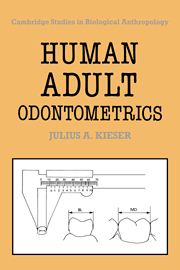Book contents
- Frontmatter
- Contents
- Foreword
- Preface
- 1 Introduction
- 2 Measurement of tooth size
- 3 Inheritance of tooth size
- 4 Comparative odontometry
- 5 Odontometric trends
- 6 Sexual dimorphism in tooth size
- 7 Odontometric variability
- 8 Compensatory tooth size interactions
- 9 Fluctuating odontometric asymmetry
- 10 Allometric relations of tooth size
- Odontometric appendix
- References
- Index
4 - Comparative odontometry
Published online by Cambridge University Press: 05 February 2012
- Frontmatter
- Contents
- Foreword
- Preface
- 1 Introduction
- 2 Measurement of tooth size
- 3 Inheritance of tooth size
- 4 Comparative odontometry
- 5 Odontometric trends
- 6 Sexual dimorphism in tooth size
- 7 Odontometric variability
- 8 Compensatory tooth size interactions
- 9 Fluctuating odontometric asymmetry
- 10 Allometric relations of tooth size
- Odontometric appendix
- References
- Index
Summary
Introduction
It is probably a reflection of the limitations of the human brain that our thought processes are so heavily dependent upon the recognition of groups. To recognise something is to incorporate it instinctively into a category or group consisting of objects that share similar characteristics. An unclassified object tends to be mentally disturbing. Small wonder that the history of human odontometrics is so tightly interwoven with the much wider issues of the classification of living organisms.
From the earliest Babylonians there emerged a conviction that form, whether manifest in anatomy or music, was capable of numerical expression. This conviction was carried forward by the Pythagorean school of philosophers who, as early as the fifth century BC, sought to describe and compare animal forms numerically (Stapleton, 1958). Limited by their inadequate geometrical techniques, Pythagorean classifications soon lost ground to the dichotomous method of classification introduced by Aristotle in the fourth century BC, which emphasised the evaluation of form rather than measurement. Later adopted by Linnaeus (Cain, 1958), Aristotelian empirical syllogistic classifications maintained their ascendancy well into the present century when they coexisted, albeit often uncomfortably, with the more quantitative Pythagorean approach (exemplified for instance in the works of D'Arcy Wentworth Thompson).
The earliest efforts at odontometric classification were based on Aristotelian logic and consisted of attempts at discovering the essence (or ‘real nature’) of different ethnic groups. Aristotelian syllogistic logic favoured the consideration of properties that are essential or inevitable consequences of being; for example, the ‘essence’ of a tooth in a plane surface is best expressed by its definition as an object reduced to length and width.
- Type
- Chapter
- Information
- Human Adult OdontometricsThe Study of Variation in Adult Tooth Size, pp. 30 - 49Publisher: Cambridge University PressPrint publication year: 1990



